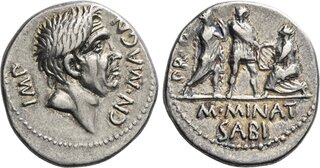| Numismatica Ars Classica > Auction 143 | Auction date: 7 May 2024 |
| Lot number: 371 Price realized: This lot is for sale in an upcoming auction - Bid on this lot  | Show similar lots on CoinArchives Find similar lots in upcoming auctions on |
| Lot description: The Dioscuri Collection. The Roman Republic. Cn. Pompeius Junior and M. Minatius Sabinus. Denarius, Spain 46-45, AR 18 mm, 3.74 g. IMP – CN MAGN Head of Cn. Pompeius Magnus r. Rev. PR·Q Pompeian soldier between the personification of two Spanish cities, the one on the l. raising her r. hand to greet him and the one on the right kneeling to present him with shield; in exergue, M·MINAT / SABI. Babelon Minatia 3 and Pompeia 12. C 9. Sydenham 1037. T. V. Buttrey, ANSMN 9, 1960, p. 77, type B and pl. VII, obv. 1, rev. e. Sear Imperators 52. RBW 1643. Crawford 470/1b. Extremely rare and in superb condition for this issue, undoubtedly among the finest specimens known. Struck on a very broad flan and with a superb light iridescent tone. About extremely fine Ex NAC 25, 2003, 326 and NAC 106, 2018, 486 sales. Among the towering figures of the late Republic was Gnaeus Pompeius, better known as Pompey 'the Great', who by his mid-20s had already earned his surname Magnus. Alongside his father Pompeius Strabo, and later in alliance with the warlord Sulla, Pompey lived in the eye of the storm that challenged the authority of the Senate. Time and time again Pompey (like his father) defied the Senate's requests to disband his armies. He was a merciless commander, crushing remnants of the Marian party in North Africa, fighting the rebel Sertorius in Spain, crushing the slave-army of Spartacus in Southern Italy, cleansing the eastern Mediterranean of pirates, and delivering the final defeat to Rome's great enemy in Asia, Mithradates VI of Pontus. After his great successes in Asia, Pompey joined Crassus and Julius Caesar to form the First Triumvirate in 60 B.C., which remained intact until 53, when Crassus died in battle against the Parthians. Soon Pompey found himself allied with the Senate against Caesar, which resulted in Caesar crossing the Rubicon in 49, forcing Pompey and his allies to flee to Greece. In the following year their conflict shifted to Greek soil, at Pharsalus, where Pompey was defeated in the famous battle, after which he fled to Egypt and was swiftly murdered. This rare denarius was struck by Pompey's eldest son, Pompey Junior, presumably at the Spanish mint of Corduba shortly before the Battle of Munda on March 17, 45. At this battle the Pompeians suffered another crushing defeat to Julius Caesar. With the possible exception of civic bronzes of Soli-Pompeiopolis in Cilicia, no portrait of Pompey appears on coinage until after his death, thus making the series to which this coin belongs his first securely dateable portrait coins. Estimate: 15000 CHF |  |



